
|
||
|
Portland art blog + news + exhibition reviews + galleries + contemporary northwest art
|
||
Justine Kurland interviewed in Portland 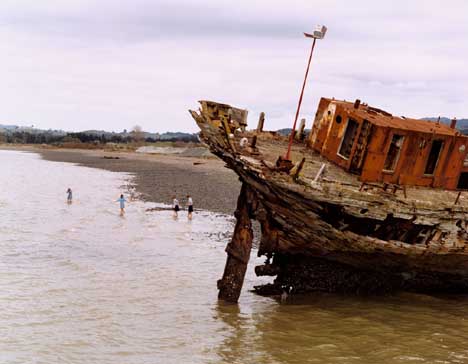 Ghost Ship, 2001 Satin finish UV laminated C-print 30 by 40 in. 76.2 by 101.6 cm. All images Courtesy Mitchell-Innes & Nash, New York. Photographer Justine Kurland has spent the past decade staking her claim in the vast territory of American myth. Her color landscapes, most often stages and backdrops for figurative tableaus, are portals to an adjacent world, a Siamese twin world comprised of unseen moments from this one. 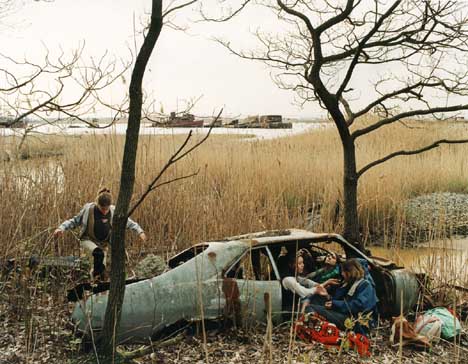 Shipwrecked, 2000 Satin finish UV laminated c-print, AP1 30 by 40 in. 76.2 by 101.6 cm. Kurland earned early accolades for her neo-romantic scenes of teenage girls adrift in the overlooked spaces of suburban wildlands. Tough, tender and imbued with the awkward grace of those years, Kurland's heroines haunt the roadway medians and empty lots of an adult landscape that seems too occupied to notice its missing daughters or the hideouts they inhabit. They soil school uniforms, torture boys, and leap off cliffs to fulfill private death pacts. They forge cliques and clubs that we viewers are not invited into. We look on with the envy of the excluded. Following projects have also focused on subcultures: Kurland shot group portraits of back-to-the-land communes like The Farm and Black Bear Ranch, traversing the country in her van. She photographed Renaissance Faire enthusiasts in their armor and Burning Man devotees in their birthday suits. Always the scenes are presented with a painterly lushness and an undisguised devotion to early photographers such as Matthew Brady, Julia Margaret Cameron, or Darius Kinsey. Motherhood, in 2004, brought a new degree of both sensitivity and chaos into Kurland's practice. Her most recent exhibition, "Of Woman Born," at Mitchell-Innes & Nash in New York, and Monte Clark in Vancouver, portrayed groups of women, pregnant or with their young children enacting private rituals in sublime natural spaces. When I happened into the show at Mitchell-Innes & Nash's Chelsea location (still lightheaded from the relentless lemon-scenting of Galerie Lelong next door), I was initially put off by the directness of the images. My experiences viewing contemporary photography are such that I often expect a picture to unveil, on examination, some hidden back-story or coded reference (the way Nikki S. Lee's own glimpses of subculture become more rewarding when you realize the artist's transformations). Instead, the immediacy of these photographs left me a bit startled and unsure if I was missing something. I was doubly on guard because I regard the latest resurgence of hippy sentiment in the art world to be shallow and insincere, a frivolous fashion trend that manifests in beards, beads, and drugs, and not in good ideas. 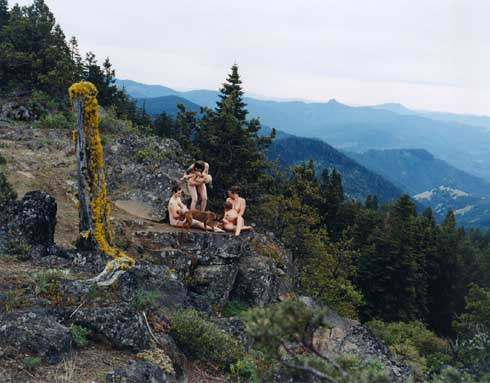 Siskiyou Mountain Tea Party, 2006 C-print,30 by 40 in. 76.2 by 101.6 cm But as I spent more and more time in the space, I was heartened by these groups of seeming Wiccans, cavorting in the landscapes of rural Oregon and Northern California with only their children and each other. Here was (perhaps embarrassingly) a group I could relate to, or at least admire, though as a male viewer it was another party I wouldn't be attending. By the time I left, back into the sleekness of Chelsea, I was intrigued and moved and a little homesick. The photographs can be unabashedly beautiful: deep views where phalanxes of hills roll back forever; mangrove trunks reflected on crystalline water; naked human bodies in poses of strength and vulnerability. Kurland, in fact, seems to be getting away with something that shouldn't work in an image culture so steeped in irony. Beautiful naked pregnant women dancing in a circle by a pristine waterfall? The premise is so saccharine, so impossibly outdated, and yet through Kurland's lens, the subjects possess complexity and sincerity, and the images read as more forthright (even the staged ones) than much documentary work. This honesty is a rare and refreshing trait in the art world. It would be easy enough to present medieval re-enactors or pagan nudists in a laughable light, but instead one comes away from the images with a feeling of shared humanity, and perhaps even a sense that we are missing something true, whether it is the convictions of a commune or the courage of a vagabond on the tracks. Kurland has, in the course of her travels, developed an affinity for Oregon. On a recent visit to lecture on her work at PNCA, she made time to spend the afternoon talking to me about the nuts and bolts of her creative process as a working mother on the road. Casper, her 3 year-old son, cooperated by napping in the "mama car-" a van Kurland has rigged up to serve as bedroom, studio and playroom- while she showed me prints from her newest body of work. Kurland has been influenced by Casper's fascination with trains, and in her recent images has turned her eye to hobo culture. The new works show crusty wanderers in abandoned rail yards, makeshift lean-tos, and panoramic Western landscapes that recall the past promise of the railroads: the grit and allure of a transient life not so unlike her own. RP: The first time I encountered your work was through the Artspace book Old Joy, which featured your photographs alongside a short story by Jonathan Raymond. What was the process of making that book? JK: A woman named Anne MacDonald had a bunch of money to put into this project- kind of a nonprofit. They've done a bunch of books, I know Nan Goldin did one and Jack Pierson did one, and I think she favors the artist. So I pulled Jon into the project RP: So she approached you. JK: Yeah. Jon was a friend of mine and he wrote that story around my photographs and then Kelly (Reichardt) made the movie around his story. So it was kind of more like a food chain than a collaboration. RP: Have you done any other collaborative work, other than what arises from working with your photographic subjects? JK: No. I mean…I feel like now I'm sort of collaborating with Casper. But I'm a really old school photographer. Now when I visit schools I refuse to do studio visits with anyone other than photography students. There's a certain vocabulary around photography that makes it so I am really comfortable to criticize someone's photographs and I just don't feel like I have the right to criticize anyone's paintings or sculptures. I'm so much more permissive with paintings and sculptures. I'm like, "Wow, you made that? That's cool." With photographs it's more like, "My God. You cannot not photograph that from that angle in that kind of way." And I feel like a dinosaur, because now it's much more about being interdisciplinary. RP: Do you think some of the craftsmanship is lost when photo departments shift their energy toward being interdisciplinary? JK: I don't know, but I was visiting Columbia (University) and there were a few photographers who were just in the weeds, who didn't have any kind of guidance. Definitely. But, I think the kind of craftsmanship that's involved in photography is maybe not such a bad thing to lose. Those materials to make those kinds of photographs are becoming extinct. Polaroid's out of business, there's less and less photo papers to print on…I don't really have that much opinion about, you know, where the digital age is going, but I think the problem with digital photography is that nobody knows what it should look like. You have all these other tools, and you can do something completely different. The reason why modernist, traditional photographs look like they do has everything to do with the lens and the chemistry and the paper. As those materials are no longer the same, it should look different. Once photography was invented, people tried to make it look like painting. They wanted soft-focus lenses and it took them a while to realize that that's not what the camera does. A camera records surface detail of the world, and that's its strength. If you're gonna fuzz it all out you're not really using this thing that photography can do. But I don't really think about that when I'm making work, or even looking at other people's work. Anyone's project sets up their own parameters, their own logic, and you try to figure out what materials fit that project. RP: Yesterday (at your lecture at PNCA) you talked both about your influences- those early modernist, romantic photographers- and about a time when you began taking road trips as part of your working process. Did your perceptions about landscape or your relationship to that romantic ideal change once you immersed yourself in the landscape this way? JK: Yeah. It totally changed. A couple of things happened at once. I started going to graduate school at Yale. I got to Yale, and the guy who runs that department is Todd Pappageorge- he's this amazing writer, incredibly articulate. So he would give these long slide lectures and say things like, "Who would have thunk that angle? He must have kicked the tri-pod but it worked!" or "This photograph is like Perseus holding the head of Medusa." He has this kind of fifth avenue lockjaw but a beautiful way of talking about photographs, and I was forced to go back through the history of photography and really kind of re-love what the camera does. I was brainwashed into this modernist doctrine. But then at the same time I learned to drive- I'd grown up in New York City, so I'd never known how to drive- but then when I got to graduate school I learned. So all of a sudden landscape was more accessible. There were these two things coming together: the re-appreciation of what a photograph can do, and this access that I suddenly had. But the thing about the way I was photographing teenage girls, you know, bringing them into the woods? That's not where a teenage runaway would go at all. That's some weird other thing that happened when I was a little girl hunting fairies with my sister, or going to Renaissance Fairs or growing up with these Mucha posters everywhere at my mom's house. She was a single mom and we were on food stamps and welfare, but at a certain time she figured out she could make clothing at home and sell them at these Renaissance Fairs and she saved up enough money. I was already out of the house when she did this, but her whole dream was just to get a farmhouse at the end of a dirt road. And she did. She has 30 acres. RP: Will you talk a bit about the commune project? How would you approach those groups of people? Were there any communes you were tempted to join? JK: Well, someone made a good point during my lecture at PNCA: there is this dilemma between the individual and the group thing. In order to create any ideal you kind of need a group to build it together, but with a commune it's always about the individual wants versus the group, more than in normal society. I'm too spoiled with my own freedom. RP: Was it hard to earn these peoples' trust when you approached them? JK: You know I chose at a certain point, because there are so many of them, to only go to secular ones. Because I feel like the religious ones have this whole other possibility where it can become a little bit more like a cult. Faith is a bizarre force. Creating delusions and realities in a way that is actually very interesting, maybe that will be something I explore one day. The secular ones actually operate more like corporations in a sense: they all have a business that they're running because none of them are totally sustainable. There's certain things- olive oil, gasoline- that they take from the outside world. So they do things like hammocks, tofu, rope sandals…a lot of them do healing or permaculture workshops or retreats. They all get college interns. It's kind of a racket- they get these kids to work for free on the garden. At Arcosante I swear to God they have a pool cleaning class. So they're kind of easy to approach. And I was doing this project from an anti-war stance. I'd tell them I was interested in places that were choosing an alternative, more holistic path towards sustainability and harmony with nature. And I believed- I still believe- that as long as you're paying tax dollars and buying gas and shopping, you can't really protest that hard against society. But it seemed like a really beautiful thing these people were doing. When I got there, though, they seemed to be these microcosms of the larger world. They had all these internal fighting for control and dominance- some people who wanted a TV and other people who didn't and, you know, people who thought there should be a bridge built over this river so that the car didn't pollute and others who didn't want to spend the money on the bridge. Some people just wanted to get stoned and not work in the garden. Communities have these life spans where idealistic people get together, but so many, like the Farm, are no longer really communal. They sort of operate like a glorified gated community. There were people making a 45-minute drive to Nashville to work whatever job and then driving back. You know, it's horrible the amount of gas that they're burning just to get back and forth, but they have this amazing history from before. In New York City the people from the farm used to run a volunteer ambulance service for places the emergency services wouldn't go. They worked in Guatemala; they had a Native American publishing service, plus the whole home birth thing: birthing centers, midwife training. It's amazing what the history is, but, you know, what it is now is very different. 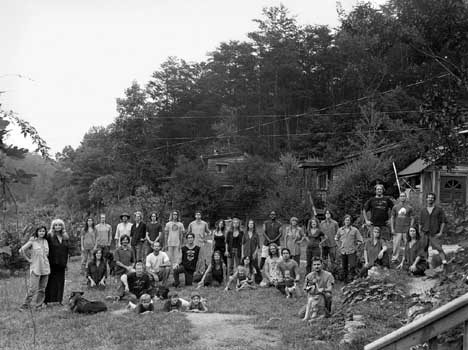 Zendik, 2002 Toned gelatin silver print 16 by 20 in. 40.6 by 50.8 cm. There's one community in North Carolina called Zendik Farm, which is by far the cult-iest and weirdest one that I went to. It's leader-based, they have arranged-coupling where the leader can break a couple up or put them together. Everything they do is very regimented. Their garden is perfectly manicured. Usually when I would shoot the group portrait, whoever feels like showing up shows up, and I would never get the whole community. But at Zendik everyone came, because Arol, who's the leader, told them to come. And they all lined up army style. They have a band that's just called Zendik. And they have a zine. What they do is, they go to a town and they're all dressed up in like climbing gear, you know with ropes hanging off their cargo pants. They all pile into these vans and go pass out their literature. They're really aggressive about it, trying to make you buy their zine and their CDs. And the music has like twenty people with this really noodly kind of Grateful Dead interpretive fusion. 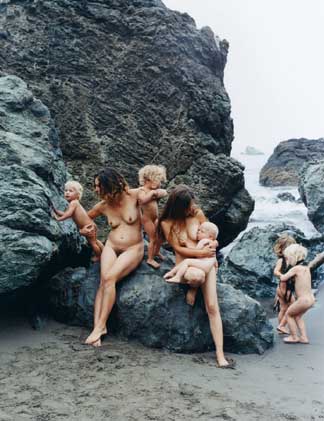 The Milk Sucker,2006 C-print 30 by 40 in. 76.2 by 101.6 cm. RP: I want to ask about the work that became "Of Woman Born," or what you call your "Mama-Baby series." It seemed to me, looking at the trajectory of your work, that this project established a new intimacy between you and your subjects. You know, you're in some of the photos and you were a member, in a way, of those groups. Did that permanently change the way you work? JK: Actually with the teenage girl pictures I was very close, and I am still really good friends with a lot of the girls from that project. I think the real departure in those (Mama-Baby) photographs for me was that they're just much more honest. I'm not trying to pretend that it's a bunch of girls running away from home and making a camp. So I was taking away some of the narrative and the fantasy and having it just be these mamas that I know. Part of my whole attraction to photographing the teenage girls was that I was in my twenties then and having this nostalgia for being a teenager. And I was younger than their parents, so they could tell me about having sex and about the drugs they did. I think they could look up to me in an older sister kind of way, so there was a definite bond with them, but then I didn't have that for a long time. I miss the girls. There would be like five girls in the back of my car all singing and they'd be so excited to get their picture taken. Teenage girls love to be photographed. The mamas were like, "Oh, I'm too fat, like, you can't photograph me from the back because my ass is too saggy. Everyone else looks great but I look terrible." So there was this whole other level of difficulty with the mamas. Really, it's so nice not to be photographing 'nakeds' anymore. When I started the nakeds, with the commune pictures, it actually came out of the fact that my mom is always naked, and I had taken a photograph of her in her garden naked. I had it on my wall for a whole year before I started those pictures, and it kind of made sense to do with the communes. Everything that I do starts out on a very personal level, and then I can pull back and realize the more sociological or feminist repercussions of the project. And I've been criticized because putting naked women in a landscape is an essentialist cliché, but I really think it makes it more interesting to address that. It's tricky. One time I sent an email to one of the mamas I met, and I had the address wrong and it ended up going to some guy. When I meet a mom I have a whole thing saying, you know, "These photographs are like this, and we're gonna go to the woods and have a picnic, and here's some of my work." And I send some attachments of photos I've already made of the mamas. But this guy got it and gave me this photo critique. He's like, "I'm not Michelle, I'm Michael, but I think you need to get closer to these women…" He had all this criticism. He was not very impressed by the work. 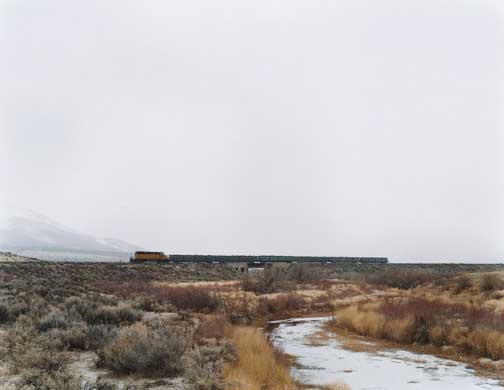 Doyle, CA: Cuervo saying it won't come and to quit so we can drive to the gas station and buy more wine, 2007 C-print 40 by 50 in. 101.6 by 127 cm. RP: Can you talk a little about your new project? JK: I'm going to show this work in September '09. I already know I'm going to title the show after a Jack Black book called "You Can't Win." It's kind of a cult classic, a memoir from the thirties. He's this gentleman thief and boxcar jumper. It's all about the Johnson-- this gang of hoboes- if you're a Johnson then you're a mensch, you know? You're a good guy. It's this etiquette among thieves. But "You Can't Win," is kind of everything about my life right now, you know, divorced, traveling with a kid, career as an artist (laughs)…yeah. Another distinction about the way I'm making this new work, or working with Casper…I always had kind of played with the idea of letting whatever I was staging unravel. With Casper, I have so much less control around what I'm doing because he could just have a fit and then I have to stop. Or I have to frame something quicker; things are just kind of done in the periphery of my thinking. I can't over think things because I only get a certain percentage of my day to think about it, and then we're talking about kitties and trains, you know? So it makes that way of working so much more a kind of channeling of something. I don't think I'm documenting or staging, I just hope I'm somehow like this medium, this wish-fulfillment medium. I'm just making it happen in the time I have and somehow that's so much better. RP: I think that artists who don't have a handicap or strategy for surprise in their life end up making it for themselves in order to keep their work fresh. JK: Well, I mean you have like the James Sienas, you know, these people who are so obsessively involved with what they're doing, and that can be great, too. But with photography, because it so clearly is what you're doing, and you can see what's happening in it so much, the more forced it is the less magical it can be. Unless you want to be really just German, and that's a whole other great direction. Like at the Met now, there's the Courbet and Poussin shows, and Courbet is clearly traveling with a kid in the van. RP: Can you describe a typical day of being on the road with Casper, working on your current project? JK: We wake up in the campground. Casper has a little toy area all set up. The mornings are pretty intense: he has really bad teeth so there's a lot of maintenance rituals. I cook him some oatmeal and make some coffee on a little camper stove. We have to pack everything up. With the train pictures, it's all about scouting for views. One time Casper was waking up from a nap and he's like, "Mama where are we? Are we looking for a view?" That's most of it. A lot of times we're just doing that all day. We'll drive around for a while, look for a view, and then we'll have a few hours to wait for a train. And I try to get him to play, something to get him tired for an afternoon nap, which is really important. I try to make it fun for him. Hopefully we'll get a picture of a train by the afternoon, and then maybe we'll head into whatever the nearest town is to get groceries and maybe stop at a playground. I'll put him in the car to take a nap and then start looking for more views. And hopefully he'll fall asleep and I can hike a little bit around the car. He'll have total protests, too, like throwing things out the car window, kicking off his shoes, anything to slow me down. We had this really bad day where he had put Goop- you know, it's sort of like slime- all in his hair. It was stuck to all his hair like rubber and wrapped around his head. And I remember yelling at him- there's some days where I'm just in tears I'm just so frustrated- I yelled "Casper! Jeff Wall does not have to spend all his time taking Goop out of his kid's hair in the middle of a photo shoot!" And he thought that was so funny, luckily, because what a horrible thing to say to my kid. Like I said, our relationship is twisted sometimes. So he says, "What else does Jeff Wall not have to do?" So now it's this thing where, like, he'll be hungry and want a peanut butter and jelly sandwich and I'll say, "Jeff Wall does not have to make peanut butter and jelly sandwiches in the middle of his photo shoot." RP: I hear Jeff Wall doesn't even have to eat. JK: He doesn't have to do anything! And one time Casper asks, "Who is Jeff Wall?" And I was like "Oh, he's just a fancy photographer." But there's these great, beautiful moments where the train finally comes and we make this beautiful photograph and Casper is there naming every car that comes by: "Union Pacific, power unit, power unit, power unit, hopper, hopper, boxcar, boxcar…" It's so great. With the Mama pictures we had more opportunity to be hiking around in the landscape, to be in the redwood forest. So that was actually a bit more magical, but he hated the social aspect of that project. This current project can be so lonely. Sometimes the only person we'll talk to all day will be the waitress at the restaurant, or the train cop that kicks us off the railroad. So, yeah, we get back to the campground, we cook dinner, which is, you know, not so good. Maybe something organic; but like some chili, crackers, some avocado. Whatever can keep without refrigeration. And we have a nice evening ritual of just playing together and then we snuggle up in the back of the car with lots of books. RP: As a New York artist who travels around to a lot of rural places, what are your impressions about the status of regionalism? Does the New York art world ever seem insular? JK: In Portland, everyone I know here is an artist. One of the reasons I love it here is that in New York there's like the celebrity artists, you know, who are like so fabulous and blow tons of coke. And there's these parties where they pat each other's backs and show each other their reviews. It becomes so self-congratulatory and gross. In Portland I feel like the artists here are more like working artists, more intellectually invested or emotionally invested in their work, and that the relative lack of an art scene here helps them keep a more alive practice. I know there's events going on here, like the opening at Small A tonight but, you know, I can't go. I've got a kid. Even in New York, I only go to the openings of close friends of mine. There was a time, when I got out of grad school, where I wanted to learn everything about the art world, to go to all the parties. But I don't really think that's necessary. 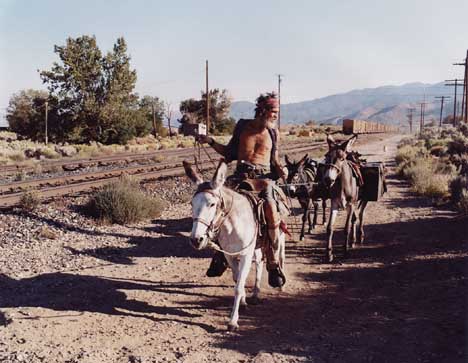 Astride Mama Burro, Now Dead,2007 C-print 40 by 50 in. 101.6 by 127 cm. RP: So you're moving to Portland? JK: Yeah, I'm coming here in the fall. I'm looking for a place to live. RP: What are you looking forward to about coming here? JK: Actually, right now I'm just scared that I won't be able to make work off the road. Since '99 I've only traveled to make work, but now Casper will be in school. This first year, we'll be able to leave for five days at a time, so that should be okay. This is the most beautiful part of the country, so I'm excited about being able to drive into the Siskiyou. But I'm scared about being settled down. I hate change. I'm a weird paradox that I'm so into traveling but I hate change. But I have such good friends here and it's so beautiful. I'm really looking forward to that. And a flushing toilet. Posted by Ryan Pierce on June 06, 2008 at 11:28 | Comments (0) Comments Post a comment Thanks for signing in, . Now you can comment. (sign out)
(If you haven't left a comment here before, you may need to be approved by
the site owner before your comment will appear. Until then, it won't appear
on the entry. Thanks for waiting.)
|
| s p o n s o r s |
 |
 |
 |
 |
 |
 |
 |
 |
 |
 |
 |
 |
 |
 |
 |
 |

|
Site Design: Jennifer Armbrust | • | Site Development: Philippe Blanc & Katherine Bovee | |

